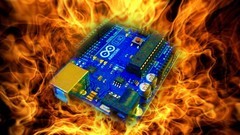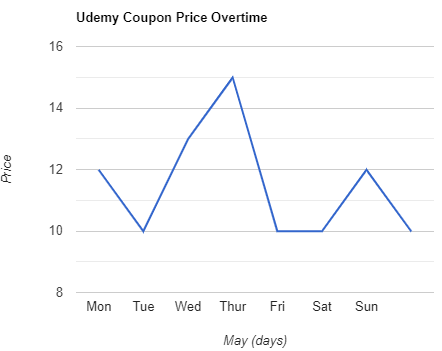Arduino Step by Step More than 50 Hours Complete Course (Udemy.com)
C Programming, Arduino, PIC Microcontroller, PCB Design, Wed Design for IOT, PID Controller Everything Included
Created by: Roshan Premarathne
Produced in 2022
 What you will learn
What you will learn
- Arduino, PIC, C Programming, IOT
 Quality Score
Quality Score
Content Quality
/
Video Quality
/
Qualified Instructor
/
Course Pace
/
Course Depth & Coverage
/
Overall Score : 88 / 100
 Live Chat with CourseDuck's Co-Founder for Help
Live Chat with CourseDuck's Co-Founder for Help
Need help deciding on a arduino course? Or looking for more detail on Roshan Premarathne's Arduino Step by Step More than 50 Hours Complete Course? Feel free to chat below.
Join CourseDuck's Online Learning Discord Community
 Course Description
Course Description
This is a Complete Arduino Course which will guide you from very basic to most advanced level. The problem for most of the students is lack of Applying programming knowledge to embedded system. So from this course you'll learn programming concepts step by step and the practical applications of each concept.
This course divided into 16 Sections
Section 01
From This Section You'll Get An Idea Of What Is A Program And Why C Is The Best Language For Embedded System Programming.
As The Practicals You'll Learn Following,
what Is An Arduino Board And The Difference Between Microprocessor And Microcontroller
the Advantage Of Power Pins, The Scanning Process Of An Arduino Program.
how To Use Digital Pins And Some Light Patterns To Understand The Basic Arduino Commands.
why We Cant Connect A DC Motor Directly To MCU. Introduction To DC Motor Drivers And How To Control The Directions.
Section 02
From This Section You'll Get An Idea Of Why We Need Variables And The Different Types Of Variables In C Language.
In Addition You'll Learn How To Get User Inputs And Basic Arithmetic Operations.
As The Practical Session You'll Learn Following,
what Is A Seven Segment And How To Interface A 7seg To Arduino.
the Advantage Of BCD To 7seg Decorders And How To Use The
how To Control 4 Digit 7seg Display Using The Frequency Method.
the Internal Architecture Of A DC Relay And Controlling 230v Devices.
also You'll Learn What Is PWM And The Theory Behind ,and Practical Application Of PWM.
Section 03
From This Section You'll Learn Why We Need Decision Making In Programmes And Four Types
Of Diffrerent Decision Making Algorithms. You'll Learn How To Use An If - Condition
Step By Step With Lots Of Examples.
As The Practical Session You'll Learn How To Interface A Pushbutton As An Application Of If - Condition
And From This Section You'll Get An Idea Of Digital Communication And Deep Understanding About RS232
Ports Of Arduino And How To Send And Receive Data Using Them. Also You Can Learn About
Wireless Communication And See Some Practical Demonstrations.
Section 04
From This Section You'll Learn If-else Condition As The Second Decision Making Algorithm. We Have Discussed Some Different Programs.
As The Practical Session You'll Learn How To Use An If-else Condition In AnArduino Program. To Demonstarte That We Have Discussed Some Advanced Push Button Interfacing Practicals Including Bit Wise Operations. You'll Also Learn About Analog To Digital Conversion And The Theory Behind That. See How To Interface An Analog Sensor Such As Soil Moisture Sensor. In This Section You Can Learn How To Control DC Servo Motors And The Sevo Mechanism. Also You'll Able To Interface A 16x2 Lcd To Arduino. By The End Of This Section You'll Learn How To Do A Complete Flower Plant Project Including All The Theories You Have Learnt So Far.
Section 05
From This Section You'll Learn If-else If-else Condition As The Third Decision Making Algorithm. Also You Can Learn The Theory Of Loops And Lot Of Examples Regarding While Loop.
In The Practical Session You'll Learn The Practical Usage Of While Loops.
Next You Can Learn How To Interface A 4x4 Keypad To The Arduino. Do You Like To Control A Large (industrial) Stepper Motors? In This Section We'll Show You Step By Step Instruction And Demonstration of How To Control Very Large Stepper Using An Arduino. By The End Of This Section You'll Be Able To Understand The Exact Mechanism Of An Ultrasonic Sensor And How To Program It To Find The Distance.
Section 06
In This Section You Can Learn The Theory Of Nested While Loops, One Dimentional Arrays And Lot Of Example Programs.
As The Practical Session We Build a Home Automation System So You Can Understand How To Use Arrays In An Arduino Program.
Section 07
From This Section You'll Learn Why We Need Sub Programs In Our Projects. Here We Explain 5 Different Types Of Functions And Some Examples Regarding Functions.
As The Practical Session You'll Learn Why We Need A Hardware Mechanism Called Interrupts And The Advantage Of Interrupts Over Polling System. Also You Can Learn How To Create Functions In An Arduino Project.
Section 08
Form this Section We'll guide you step by step to making an obstacle avoiding and Maze Solving Robot. in this Section We demonstrate Several Algorithms for making an Obstacle Avoiding Robot and Each Steps will Demonstrate.
Section 09
From This Section You'll Get An Idea About The For Loop And How To Use That With Examples.
As The Practical Session You'll Learn The Importance Of Creating Software Interfaces For Embedded System Applications. Here We Introduce How To Create A Visual Basic Interface And Start The Communication With Arduino.
Section 10
From This Section You'll Learn The Importance Of Learning PIC Microcontroller. Here We Explain The Pinout, RAM, Special Memories Such As PORT And TRIS. And You Also Learn How To Use In Built PIC Libraries. Also Learn How To Get Data (18B20 Temperature) From Ar Arduino To VB Interface.
Section 11
In This Section We Are Giving You An Assignment To Test Your C Programming Knowledge. And You Can Study Further About PIC Microcontroller With Proteus Simulations. You Can Learn The Important Of An EEPROM And How To Access Arduino EEPROM. Also Learn How To Send And Recieve SMS And How To Make Or Answer A Call Using Arduino With The Help Of A GSM Module.
Section 12
From This Section You'll Learn How To Group Related Variables Together Using Structures. And Learn How To Create And Handle A Database In Visual Basic So That You Can Create A Storing Mechanism For An Arduino Project.
Section 13
From This Section You'll Learn How To Deal With String Type Data In A C Program.
As The Practical Session You'll Learn About I2C Communication And How To Interface A Real Time Clock Such As DS1307 Using The I2C Port Of The Arduino. Also You Can Learn How To Make A PCB For Any Arduino Project Using Eagle Cad Software.
Section 14
From This Section You'll Understand The Importance Of IOT Platform. How To Access A Device Through The Internet And How To Submit An Arduino Data To A Web Server. To Do That We Guide You Step By Step How To Make A Web Site Using Visual Web Developer (ASP) And How To Launch The Web Site And Finally How To Connect Arduino To The Web Server.
Section 15
From This Section You'll Learn How To Make A Line Following Robot Using Pololu QTR8 Sensor Array. Before That You'll Get A Very Deep Understanding About PID Control System. Propotional Controller, PI Controller And PD Controller. Also You'll Understand About Overshoot Error And The Oscillation Error.
Section 16
This course divided into 16 Sections
Section 01
From This Section You'll Get An Idea Of What Is A Program And Why C Is The Best Language For Embedded System Programming.
As The Practicals You'll Learn Following,
what Is An Arduino Board And The Difference Between Microprocessor And Microcontroller
the Advantage Of Power Pins, The Scanning Process Of An Arduino Program.
how To Use Digital Pins And Some Light Patterns To Understand The Basic Arduino Commands.
why We Cant Connect A DC Motor Directly To MCU. Introduction To DC Motor Drivers And How To Control The Directions.
Section 02
From This Section You'll Get An Idea Of Why We Need Variables And The Different Types Of Variables In C Language.
In Addition You'll Learn How To Get User Inputs And Basic Arithmetic Operations.
As The Practical Session You'll Learn Following,
what Is A Seven Segment And How To Interface A 7seg To Arduino.
the Advantage Of BCD To 7seg Decorders And How To Use The
how To Control 4 Digit 7seg Display Using The Frequency Method.
the Internal Architecture Of A DC Relay And Controlling 230v Devices.
also You'll Learn What Is PWM And The Theory Behind ,and Practical Application Of PWM.
Section 03
From This Section You'll Learn Why We Need Decision Making In Programmes And Four Types
Of Diffrerent Decision Making Algorithms. You'll Learn How To Use An If - Condition
Step By Step With Lots Of Examples.
As The Practical Session You'll Learn How To Interface A Pushbutton As An Application Of If - Condition
And From This Section You'll Get An Idea Of Digital Communication And Deep Understanding About RS232
Ports Of Arduino And How To Send And Receive Data Using Them. Also You Can Learn About
Wireless Communication And See Some Practical Demonstrations.
Section 04
From This Section You'll Learn If-else Condition As The Second Decision Making Algorithm. We Have Discussed Some Different Programs.
As The Practical Session You'll Learn How To Use An If-else Condition In AnArduino Program. To Demonstarte That We Have Discussed Some Advanced Push Button Interfacing Practicals Including Bit Wise Operations. You'll Also Learn About Analog To Digital Conversion And The Theory Behind That. See How To Interface An Analog Sensor Such As Soil Moisture Sensor. In This Section You Can Learn How To Control DC Servo Motors And The Sevo Mechanism. Also You'll Able To Interface A 16x2 Lcd To Arduino. By The End Of This Section You'll Learn How To Do A Complete Flower Plant Project Including All The Theories You Have Learnt So Far.
Section 05
From This Section You'll Learn If-else If-else Condition As The Third Decision Making Algorithm. Also You Can Learn The Theory Of Loops And Lot Of Examples Regarding While Loop.
In The Practical Session You'll Learn The Practical Usage Of While Loops.
Next You Can Learn How To Interface A 4x4 Keypad To The Arduino. Do You Like To Control A Large (industrial) Stepper Motors? In This Section We'll Show You Step By Step Instruction And Demonstration of How To Control Very Large Stepper Using An Arduino. By The End Of This Section You'll Be Able To Understand The Exact Mechanism Of An Ultrasonic Sensor And How To Program It To Find The Distance.
Section 06
In This Section You Can Learn The Theory Of Nested While Loops, One Dimentional Arrays And Lot Of Example Programs.
As The Practical Session We Build a Home Automation System So You Can Understand How To Use Arrays In An Arduino Program.
Section 07
From This Section You'll Learn Why We Need Sub Programs In Our Projects. Here We Explain 5 Different Types Of Functions And Some Examples Regarding Functions.
As The Practical Session You'll Learn Why We Need A Hardware Mechanism Called Interrupts And The Advantage Of Interrupts Over Polling System. Also You Can Learn How To Create Functions In An Arduino Project.
Section 08
Form this Section We'll guide you step by step to making an obstacle avoiding and Maze Solving Robot. in this Section We demonstrate Several Algorithms for making an Obstacle Avoiding Robot and Each Steps will Demonstrate.
Section 09
From This Section You'll Get An Idea About The For Loop And How To Use That With Examples.
As The Practical Session You'll Learn The Importance Of Creating Software Interfaces For Embedded System Applications. Here We Introduce How To Create A Visual Basic Interface And Start The Communication With Arduino.
Section 10
From This Section You'll Learn The Importance Of Learning PIC Microcontroller. Here We Explain The Pinout, RAM, Special Memories Such As PORT And TRIS. And You Also Learn How To Use In Built PIC Libraries. Also Learn How To Get Data (18B20 Temperature) From Ar Arduino To VB Interface.
Section 11
In This Section We Are Giving You An Assignment To Test Your C Programming Knowledge. And You Can Study Further About PIC Microcontroller With Proteus Simulations. You Can Learn The Important Of An EEPROM And How To Access Arduino EEPROM. Also Learn How To Send And Recieve SMS And How To Make Or Answer A Call Using Arduino With The Help Of A GSM Module.
Section 12
From This Section You'll Learn How To Group Related Variables Together Using Structures. And Learn How To Create And Handle A Database In Visual Basic So That You Can Create A Storing Mechanism For An Arduino Project.
Section 13
From This Section You'll Learn How To Deal With String Type Data In A C Program.
As The Practical Session You'll Learn About I2C Communication And How To Interface A Real Time Clock Such As DS1307 Using The I2C Port Of The Arduino. Also You Can Learn How To Make A PCB For Any Arduino Project Using Eagle Cad Software.
Section 14
From This Section You'll Understand The Importance Of IOT Platform. How To Access A Device Through The Internet And How To Submit An Arduino Data To A Web Server. To Do That We Guide You Step By Step How To Make A Web Site Using Visual Web Developer (ASP) And How To Launch The Web Site And Finally How To Connect Arduino To The Web Server.
Section 15
From This Section You'll Learn How To Make A Line Following Robot Using Pololu QTR8 Sensor Array. Before That You'll Get A Very Deep Understanding About PID Control System. Propotional Controller, PI Controller And PD Controller. Also You'll Understand About Overshoot Error And The Oscillation Error.
Section 16
 Instructor Details
Instructor Details

- 4.4 Rating
 40 Reviews
40 Reviews
Roshan Premarathne
Hi, I'm Roshan an electronic engineer and teacher with an experience over 5 years. I'm Currently running a robotic institute in Colombo Sri Lanka. (Sri Lanka Institute of Robotics). So far I have taught and trained over 1000 students. I think it's time to contribute my knowledge and experience to World Wide students who loves robotics.







